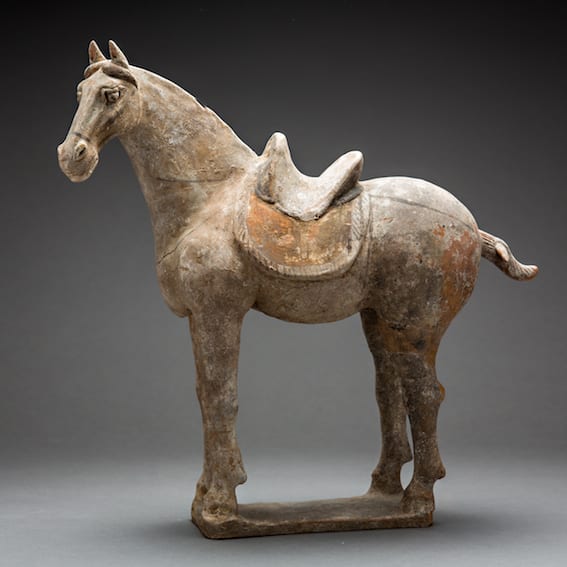Tang Sculpture of a Horse, 618 CE - 906 CE
Painted Terracotta
38.4 x 41 cm
15 1/8 x 16 1/8 in
15 1/8 x 16 1/8 in
X.0405
Further images
During the Tang dynasty, China enjoyed a period of consolidation, achievement, and confidence. Pottery of this era is often compared to that of Classical Greece for the sophisticated achievements in...
During the Tang dynasty, China enjoyed a period of consolidation, achievement, and confidence. Pottery of this era is often compared to that of Classical Greece for the sophisticated achievements in sculpting and modeling. This statue resembles a portrait of an individual horse with its lifelike modeling and expressive facial features. Strong, noble, and splendid, this painted terracotta horse conveys the love and admiration that Tang aristocrats felt toward its steeds. Horses held particular significance with Tang rulers and aristocrats, who relied on them for military preparedness and diplomatic policy.
The horse here depicted is of a large and spirited breed much sought after by the Chinese. Originating in the grasslands of Inner Asia, such horses were much larger than the pony native to China, hence valued for their speed and nobility. Indeed owing a horse became a privilege in Tang China when, in 667 an edict decreed that only aristocrats (of both sexes) could ride horses.
Clearly, this horse was a beloved creature buried alongside the deceased to accompany him throughout eternity. Wearing harnesses, a saddle, and a painted numnah, the horse is ready to gallop across the eternal fields of the afterlife, carrying the spirit of the deceased upon its back.
The horse here depicted is of a large and spirited breed much sought after by the Chinese. Originating in the grasslands of Inner Asia, such horses were much larger than the pony native to China, hence valued for their speed and nobility. Indeed owing a horse became a privilege in Tang China when, in 667 an edict decreed that only aristocrats (of both sexes) could ride horses.
Clearly, this horse was a beloved creature buried alongside the deceased to accompany him throughout eternity. Wearing harnesses, a saddle, and a painted numnah, the horse is ready to gallop across the eternal fields of the afterlife, carrying the spirit of the deceased upon its back.





